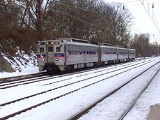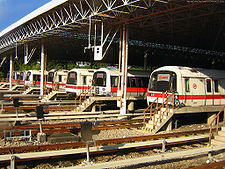
Electric multiple unit
Encyclopedia
An electric multiple unit or EMU is a multiple unit
train consisting of self-propelled carriages, using electricity
as the motive power. An EMU requires no separate locomotive
, as electric traction motor
s are incorporated within one or a number of the carriages. Most EMUs are used for passenger trains, but some have been built or converted for specialised non-passenger roles, such as carrying mail or luggage, or in departmental use, for example as de-icing trains. An EMU is usually formed of two or more semi-permanently coupled carriages, but electrically powered single-unit railcar
s are also generally classed as EMUs.
EMUs are popular on commuter and suburban rail networks around the world due to their fast acceleration and pollution-free operation. Being quieter than DMU
s and locomotive
-drawn trains, EMUs can operate later at night and more frequently without disturbing residents living near the railway lines. In addition, tunnel design for EMU trains is simpler as provisions do not need to be made for diesel exhaust fumes.
 The first EMUs were used on the elevated Liverpool Overhead Railway
The first EMUs were used on the elevated Liverpool Overhead Railway
in 1893. The southern terminal of the railway was underground, giving the LOR the distinction of also being the first to use EMUs underground. Each carriage had its own electric traction motor and was specifically designed and constructed to be light in weight running on elevated steel sections. The first EMUs were two carriage trains later graduating to three carriages, with the front and rear carriages powered. Liverpool Museum retains an example of the Liverpool Overhead Railway EMU carriage.
in Japan
and ICE 3
in Germany
. The retired New York-Washington Metroliner service, first operated by the Pennsylvania Railroad
and later by Amtrak
, also featured high-speed electric multiple unit cars.
Multiple unit
The term multiple unit or MU is used to describe a self-propelled carriages capable of coupling with other units of the same or similar type and still being controlled from one driving cab. The term is commonly used to denote passenger trainsets consisting of more than one carriage...
train consisting of self-propelled carriages, using electricity
Electricity
Electricity is a general term encompassing a variety of phenomena resulting from the presence and flow of electric charge. These include many easily recognizable phenomena, such as lightning, static electricity, and the flow of electrical current in an electrical wire...
as the motive power. An EMU requires no separate locomotive
Locomotive
A locomotive is a railway vehicle that provides the motive power for a train. The word originates from the Latin loco – "from a place", ablative of locus, "place" + Medieval Latin motivus, "causing motion", and is a shortened form of the term locomotive engine, first used in the early 19th...
, as electric traction motor
Traction motor
Traction motor refers to an electric motor providing the primary rotational torque of a machine, usually for conversion into linear motion ....
s are incorporated within one or a number of the carriages. Most EMUs are used for passenger trains, but some have been built or converted for specialised non-passenger roles, such as carrying mail or luggage, or in departmental use, for example as de-icing trains. An EMU is usually formed of two or more semi-permanently coupled carriages, but electrically powered single-unit railcar
Railcar
A railcar, in British English and Australian English, is a self-propelled railway vehicle designed to transport passengers. The term "railcar" is usually used in reference to a train consisting of a single coach , with a driver's cab at one or both ends. Some railways, e.g., the Great Western...
s are also generally classed as EMUs.
EMUs are popular on commuter and suburban rail networks around the world due to their fast acceleration and pollution-free operation. Being quieter than DMU
Diesel multiple unit
A diesel multiple unit or DMU is a multiple unit train consisting of multiple carriages powered by one or more on-board diesel engines. They may also be referred to as a railcar or railmotor, depending on country.-Design:...
s and locomotive
Locomotive
A locomotive is a railway vehicle that provides the motive power for a train. The word originates from the Latin loco – "from a place", ablative of locus, "place" + Medieval Latin motivus, "causing motion", and is a shortened form of the term locomotive engine, first used in the early 19th...
-drawn trains, EMUs can operate later at night and more frequently without disturbing residents living near the railway lines. In addition, tunnel design for EMU trains is simpler as provisions do not need to be made for diesel exhaust fumes.
History

Liverpool Overhead Railway
The Liverpool Overhead Railway was the world's first electrically operated overhead railway. The railway was carried mainly on iron viaducts, with a corrugated iron decking, onto which the tracks were laid. It ran close to the River Mersey in Liverpool, England, following the line of Liverpool Docks...
in 1893. The southern terminal of the railway was underground, giving the LOR the distinction of also being the first to use EMUs underground. Each carriage had its own electric traction motor and was specifically designed and constructed to be light in weight running on elevated steel sections. The first EMUs were two carriage trains later graduating to three carriages, with the front and rear carriages powered. Liverpool Museum retains an example of the Liverpool Overhead Railway EMU carriage.
Types
The cars that form a complete EMU set can usually be separated by function into four types: power car, motor car, driving car, and trailer car. Each car can have more than one function, such as a motor-driving car or power-driving car.- A power car carries the necessary equipment to draw power from the electrified infrastructureRailway electrification systemA railway electrification system supplies electrical energy to railway locomotives and multiple units as well as trams so that they can operate without having an on-board prime mover. There are several different electrification systems in use throughout the world...
, such as pickup shoes for third rail systemsThird railA third rail is a method of providing electric power to a railway train, through a semi-continuous rigid conductor placed alongside or between the rails of a railway track. It is used typically in a mass transit or rapid transit system, which has alignments in its own corridors, fully or almost...
and pantographsPantograph (rail)A pantograph for rail lines is a hinged electric-rod device that collects electric current from overhead lines for electric trains or trams. The pantograph typically connects to a one-wire line, with the track acting as the ground wire...
for over head systemsOverhead linesOverhead lines or overhead wires are used to transmit electrical energy to trams, trolleybuses or trains at a distance from the energy supply point...
, and transformers. - Motor cars carry the traction motorTraction motorTraction motor refers to an electric motor providing the primary rotational torque of a machine, usually for conversion into linear motion ....
s to move the train, and are often combined with the power car to avoid high-voltage inter-car connections. - Driving cars are similar to a cab carControl car (rail)A control car is a generic term for a non-powered railroad vehicle that can control operation of a train from the end opposite to the position of the locomotive...
, containing a driver's cab for controlling the train. An EMU will usually have two driving cars at its outer ends. - Trailer cars are any cars that carry little or no traction or power related equipment, and are similar to passenger cars in a locomotive-hauled train. On third rail systems the outer vehicles usually carry the pick up shoes, with the motor vehicles receiving the current via intra-unit connections.
Examples
Some of the more famous electric multiple units in the world are high speed trains: the ShinkansenShinkansen
The , also known as THE BULLET TRAIN, is a network of high-speed railway lines in Japan operated by four Japan Railways Group companies. Starting with the Tōkaidō Shinkansen in 1964, the network has expanded to currently consist of of lines with maximum speeds of , of Mini-shinkansen with a...
in Japan
Japan
Japan is an island nation in East Asia. Located in the Pacific Ocean, it lies to the east of the Sea of Japan, China, North Korea, South Korea and Russia, stretching from the Sea of Okhotsk in the north to the East China Sea and Taiwan in the south...
and ICE 3
ICE 3
ICE 3 is a family of high-speed EMUs of Deutsche Bahn. It includes classes 403 and 406, which are known as ICE 3 and ICE 3M respectively...
in Germany
Germany
Germany , officially the Federal Republic of Germany , is a federal parliamentary republic in Europe. The country consists of 16 states while the capital and largest city is Berlin. Germany covers an area of 357,021 km2 and has a largely temperate seasonal climate...
. The retired New York-Washington Metroliner service, first operated by the Pennsylvania Railroad
Pennsylvania Railroad
The Pennsylvania Railroad was an American Class I railroad, founded in 1846. Commonly referred to as the "Pennsy", the PRR was headquartered in Philadelphia, Pennsylvania....
and later by Amtrak
Amtrak
The National Railroad Passenger Corporation, doing business as Amtrak , is a government-owned corporation that was organized on May 1, 1971, to provide intercity passenger train service in the United States. "Amtrak" is a portmanteau of the words "America" and "track". It is headquartered at Union...
, also featured high-speed electric multiple unit cars.
Gallery
See also
- Air brakeAir brake (rail)An air brake is a conveyance braking system actuated by compressed air. Modern trains rely upon a fail-safe air brake system that is based upon a design patented by George Westinghouse on March 5, 1872. The Westinghouse Air Brake Company was subsequently organized to manufacture and sell...
- Railway brakesBrake (railway)Brakes are used on the cars of railway trains to enable deceleration, control acceleration or to keep them standing when parked. While the basic principle is familiar from road vehicle usage, operational features are more complex because of the need to control multiple linked carriages and to be...
- Diesel multiple unitDiesel multiple unitA diesel multiple unit or DMU is a multiple unit train consisting of multiple carriages powered by one or more on-board diesel engines. They may also be referred to as a railcar or railmotor, depending on country.-Design:...
- Diesel locomotiveDiesel locomotiveA diesel locomotive is a type of railroad locomotive in which the prime mover is a diesel engine, a reciprocating engine operating on the Diesel cycle as invented by Dr. Rudolf Diesel...
- Multiple Units
- British diesel and electric multiple unitsBritish diesel and electric multiple units'Multiple Unit' is a term used to describe a train which does not have a separate locomotive. Typically these are passenger trains with accommodation in every vehicle and motors or engines distributed under the floor along the length of the train...

